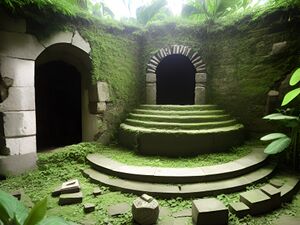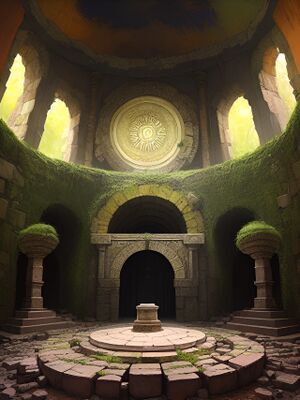No edit summary |
(→Layout) |
||
| Line 2: | Line 2: | ||
== Layout == | == Layout == | ||
[[:File:Igapó-Yvyraí-Tembetá-map.png|Map of Igapó Yvyraí Tembetá]] | |||
The temple ruins of Igapó Yvyraí Tembetá unfurl across the landscape like a mesmerizing labyrinth, enveloped in the verdant embrace of the Igapó-Açu River's surroundings. Overgrown paths, intertwined with resilient roots and delicate vines, wind through the ruins, leading explorers deeper into the heart of this ancient temple. Crumbling stone archways and moss-clad columns stand as ancient sentinels, their weathered surfaces whispering tales of forgotten rituals and sacred gatherings. Amidst the tangled foliage, courtyards with sun-kissed remnants of ornate altars and ceremonial spaces unveil glimpses of the temple's grandeur from centuries past. | The temple ruins of Igapó Yvyraí Tembetá unfurl across the landscape like a mesmerizing labyrinth, enveloped in the verdant embrace of the Igapó-Açu River's surroundings. Overgrown paths, intertwined with resilient roots and delicate vines, wind through the ruins, leading explorers deeper into the heart of this ancient temple. Crumbling stone archways and moss-clad columns stand as ancient sentinels, their weathered surfaces whispering tales of forgotten rituals and sacred gatherings. Amidst the tangled foliage, courtyards with sun-kissed remnants of ornate altars and ceremonial spaces unveil glimpses of the temple's grandeur from centuries past. | ||
Latest revision as of 01:17, 28 May 2023



Nestled near the serene banks of the Igapó-Açu River in Brazil, the Igapó Yvyraí Tembetá stands as a captivating testament to a forgotten era. Its weathered ruins whisper tales of ancient mysticism and profound spirituality, its moss-covered stones evoking a sense of timeless wisdom. Surrounded by the lush embrace of a flooded forest, this enigmatic temple, once revered by an unknown civilization, now stands as a silent sentinel, its secrets veiled in the mists of time, beckoning the intrepid few who dare to explore its hallowed grounds and unlock the profound mysteries it holds within.
Layout
The temple ruins of Igapó Yvyraí Tembetá unfurl across the landscape like a mesmerizing labyrinth, enveloped in the verdant embrace of the Igapó-Açu River's surroundings. Overgrown paths, intertwined with resilient roots and delicate vines, wind through the ruins, leading explorers deeper into the heart of this ancient temple. Crumbling stone archways and moss-clad columns stand as ancient sentinels, their weathered surfaces whispering tales of forgotten rituals and sacred gatherings. Amidst the tangled foliage, courtyards with sun-kissed remnants of ornate altars and ceremonial spaces unveil glimpses of the temple's grandeur from centuries past.
History
This temple was built by the Yámana people who emerged around 8000 BCE near the Igapó-Açu River in Brazil. Rooted deeply in the lush, mysterious heart of the Amazon, they found themselves surrounded by an abundance of natural resources and began to develop a complex society. Evidence suggests that the temple was originally built to some long unknown and forgotten deity but was adopted around 5000 BCE to house a sacred artifact.
Early Yámana culture was deeply spiritual, their beliefs closely interwoven with the dense jungle that enveloped them. They venerated the natural elements around them, seeing spirits in the river, the trees, the animals, and even the stones. This belief in the interconnectivity of all life forms fostered a deep respect for their environment and guided their everyday actions.
Over centuries, the Yámana people gradually built the Igapó Yvyraí Tembetá, a grand temple that stood as a monumental testament to their profound spiritual beliefs. The temple became the heart of their community, a sacred space where they conducted their most important ceremonies and rituals.
Around 5000 BCE, the Yámana people discovered an artifact unlike anything they had ever seen - a strange, rystalline sculpture of a small, child-like figure they would come to call the Heart of Azathoth. Believed to have fallen from the sky, this eerie artifact was seen as a gift from the gods, its alien rhythm matching the heartbeat of the universe itself. The Heart of Azathoth was placed at the center of their religious practices, its inscrutable energy guiding the Yámana people in their journey towards spiritual enlightenment.
From this point forward, the Yámana people's culture began to evolve dramatically. The influence of the Heart of Azathoth was profound. The temple of Igapó Yvyraí Tembetá was remodeled to incorporate the artifact into its architecture, creating a mesmerizing labyrinth that was both a place of worship and a tribute to the cosmos.
The Heart of Azathoth was believed to endow the Yámana with knowledge and power, fostering their understanding of the universe and their place within it. Their civilization flourished, their knowledge of agriculture, astronomy, and architecture advancing rapidly under the artifact's influence. They thrived for thousands of years, their culture deeply entwined with the Heart of Azathoth.
But, around 1200 BCE, something unexplained happened. The thriving Yámana civilization suddenly and abruptly disappeared. No trace of their existence remained, save for the enigmatic temple of Igapó Yvyraí Tembetá. The Heart of Azathoth, once the pulsating core of their civilization, had vanished along with them.
Despite numerous expeditions and archaeological investigations, no conclusive evidence has been found to explain the sudden disappearance of the Yámana people. Their abrupt end remains one of the greatest mysteries of the ancient world. The temple of Igapó Yvyraí Tembetá now stands as a silent testament to their lost civilization, a poignant reminder of their profound spirituality and their enigmatic artifact, the Heart of Azathoth.